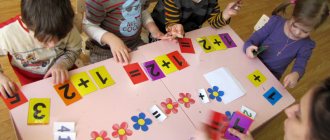Card index Didactic games for developing children's knowledge about healthy lifestyle
Card index
Didactic games to develop children's knowledge about healthy lifestyle
DIDACTICAL GAMES AND GAME EXERCISES.
Game "My Face"
Goals.
Teach knowledge of yourself, your individuality.
Teach children how to make a human face (using various objects). Develop fine motor skills of the hands. Reinforce children's concepts of color ( blue, green, gray, brown eyes).
Strengthen the idea of parts of the face;
activate vocabulary: eyes, mouth, lips, nose, eyebrows.
Develop tactile sensations.
Material.
Multi-colored braid, buttons, sticks, plasticine, sandpaper, velvet paper, foam rubber.
Content.
Using various materials, children make up a person or his face, give a descriptive story about the face, its shape, etc.
Game "Clean Hands"
Goals.
Teach the sequence of actions of the washing process.
Activate vocabulary: soap, washcloth, brush, towel.
Form the need for compliance with personal hygiene rules. Teach practical development of healthy lifestyle skills.
Material.
Pictures with rules, toiletries; small toys; three-dimensional animal figures; objects of labor.
Content.
1st option
- the teacher asks the children to choose pictures that correspond to the rule when it is necessary to wash their hands, and according to the picture, find three-dimensional objects.
2nd option -
The teacher invites children to imitate the movements of the washing process (creativity and imagination develops).
Didactic game “I can - I can’t”
Goals.
Intensify children's attention to their skills and physical capabilities of their body. Develop research activities, cultivate self-esteem.
Content.
Any number of children can participate in the game (from 1 to 10).
The presenter throws the ball to the child and says “I can” or “I can’t.” The child, having caught the ball, must continue the phrase, explaining why he knows how to do it (what helps him) or does not know how to do it (can he learn), and return the ball to the leader. For example,
“I can run because I have legs.” "I can't fly because I don't have wings."
Didactic game "Find a pair"
Target.
Exercise children in selecting identical plates by comparing their surfaces using tactile sensations (blindfolded).
Content.
Plates covered with foil, velvet paper, fur, flannel, silk, as well as metal and wooden plates are placed in front of the children. Children choose one plate at a time, and then take turns looking for the second one by touch.
Note
The child must explain what helped him correctly identify different materials.
Didactic game “Identify by touch”
Target.
Exercise children in guessing familiar objects by touch, naming the signs of this object
Content.
The child must identify the object in the “wonderful bag” by touch and characterize it, highlighting as many features as possible. The teacher offers to name the color of the object and finds out why it is impossible to do this. In order to complicate the game, you should put only one item in the bag for guessing, first | showing it to the other children. For each correct answer, a chip is awarded.
Didactic game “All helpers are important, all helpers are needed, but who needs which one more?”
Goals.
Activate children's knowledge about the dominant development of a particular sense organ for people of a certain profession.
Activate the vocabulary: cook, intelligence officer, conductor, perfumer, magician.
Content.
Each player receives a large card with the image of a person of a certain profession. On the table there are small cards with the image of one or another sense organ.
Players take turns taking out one small card at a time and either keeping it if it matches the image on the large card (i.e. if this sense organ is important for people in this profession), or returning it back (for example,
to a large card with the image perfumer, the child picks up a small card with a nose on it). The game ends when each player has one small card that matches the big one. Players then take turns justifying their choice. The rest of the players listen carefully and evaluate the correctness. The winner is the one who did not make a single mistake or made a minimum number of inaccuracies.
Note.
The number of cut cards should be more than necessary. You can offer a game option in which each child has the right to choose several large cards. This becomes possible as preschoolers acquire relevant knowledge about the peculiarities of the development of a certain sense organ in people of different professions.
Game exercise
“Who can count the buttons faster?”
Target.
Intensify children's attention to the fact that a large number of analyzers involved in the work make it easier to perform any work.
Content .
The child is asked to count the number of buttons on his shirt (jacket, dress, coat, fur coat) -
in two ways: only by touch or by feeling and
looking
at them.
Note.
Talk with children about in what cases it is possible to count faster and why.
Game exercise “Let's talk without words”
Target.
Exercise Children in understanding the meaning of certain gestures, postures, and facial expressions of a person.
Content.
The teacher invites the children to guess the meaning of his gestures
(greeting, farewell, threat
, etc.), facial expressions
(surprise, joy, anger
, etc.), posture
(confusion, fatigue, well-being
, etc.). 3the children are given the task to give examples of use; various gestures, changes in posture and facial expressions in order to understand each other without words.
Game exercise “Listen to your body”
Target.
Introduce children to basic techniques: relaxation, which has a positive effect on well-being and self-awareness.
Content.
The teacher invites the children to sit or lie down comfortably, close their eyes, relax (relax their arms, legs, whole body), listen to themselves, how the internal organs of the body work (how the blood pulsates in time with the beats of the heart, how smoothly we breathe while in calm state, etc.).
Didactic game “Identify by sound”
Target.
Exercise your hearing organs in identifying and distinguishing different sounds.
Content.
To play the game, children are divided into two teams and sit with their backs to the teacher. The teacher imitates various sounds using various objects and instruments. To do this, you can use musical instruments, paper, foil, an inflatable balloon, glass and metal dishes, a pump for inflating balls, a rubber squeak toy, etc. Players from each team take turns guessing the sound. The winning team is the one that gives more correct answers and makes fewer mistakes. For each correct answer, the team receives a chip.
Didactic game “Guess who called” (“Who said “meow”?”)
Target.
Train the hearing organs and activate the attention and auditory memory of children.
Content
The driver, standing with his back to the players, must determine who called him (or said the word “meow”). If the answer is correct, the leader’s place is taken by the child whose vote was determined
To complicate the game, children can be given a rattle. The teacher points to the next player who must rattle his rattle. The driver determines which of the game participants rattled the rattle. In this case, the driver can stand in
circle, his eyes should be closed.
Musical and didactic game “Guess where Mishka traveled”
Target.
Using tape recordings, train children in the perception of various sounds.
Content
Children are invited to listen to recordings of the rustling of leaves, birdsong, sounds made by trains and cars, the sound of the sea surf, etc. The guys must guess the sounds they heard and tell what thoughts they evoke.
Didactic game “Don’t miss your sound”
Goals.
Develop children's phonemic hearing.
Content.
The teacher invites each child to be the house of some sound (the children themselves choose and name whose house they will be). To do this, they choose a badge with the image of any sound of the Russian language ([р], [о], [у], etc. ). While listening to a poem (story), children determine the first sound of each word. Having heard a word with its “own” sound, the child needs to quickly get up and sit down. The teacher monitors the correct completion of the task.
Game exercise “Say quietly, loudly.
When is it best to hear and why?”
Goals.
Develop children's hearing. Intensify their attention to the strength of their voice, at which their speech will be clearly heard. Form a culture of speech.
Content.
The driver stands at a distance of 3-4 meters from other children and gives commands to the players, periodically changing the strength of his voice. Children follow commands. Then the adult finds out why the children performed some commands incorrectly. The guys come to the conclusion that they need to pronounce commands loudly and clearly. And their ears helped them hear the commands.
Game exercise “Whose eyes will help you?”
Target.
To consolidate children's knowledge about the visual features of living organisms.
Content.
The teacher offers each child a situation to solve which he has the right to use the eyes of any animal (walk through a dark cave, count beads, get a pearl from the seabed, etc.).
Game exercise to develop the eye
Goals.
To develop children's eye, teach them to correlate the size of objects, the length of segments, etc.
Content
Children are asked to complete a number of tasks. Several children can perform the same task at the same time.
· Mark the center of the circle with a pencil.
· Divide the rectangle in half.
· Draw a line of the same length.
· Cut a strip of the same size.
· Cut out the same shape.
Then the teacher helps to check how accurately the tasks have been completed and, if necessary, gives recommendations.
Didactic game “What can you bite with your teeth?”
Target.
To develop children’s ability to establish the positive and negative effects of foods they eat on their teeth.
Content.
Children stand in a circle.
The leading adult or child (depending on the age of the children in the group) names objects and products (for example, a stone, a bun, a cutlet, a bone, a finger, a nut
, etc.). Children say “yes” and raise their hands up if it can be bitten with the teeth, or they say “no” and squat down if it cannot be bitten with the teeth.


